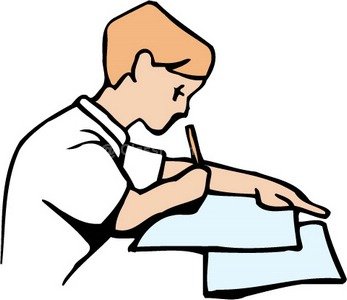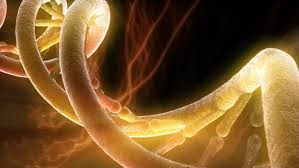Week 11 - Healthy Human Body Systems
| Site: | MoodleHUB.ca 🍁 |
| Course: | Science 8 LearnNet |
| Book: | Week 11 - Healthy Human Body Systems |
| Printed by: | Guest user |
| Date: | Monday, 17 November 2025, 5:41 PM |
Description
Week 11 - Healthy Human Body Systems
1. Respiratory System
Lesson 9
Science in Action 8
Read pages 132-134
ScienceFocus 8
Pages 126-153
| Welcome to the exciting biological world of your own body. Countless lifetimes of study can now bring you an understanding of how it functions. One of the most important ideas to remember is that, although we study organ systems separately, they must all work together to function properly. But its very difficult to discuss how body systems work without using a common vocabulary. So if you learn the names of the parts of the body we will discussing below you will find it much easier. |
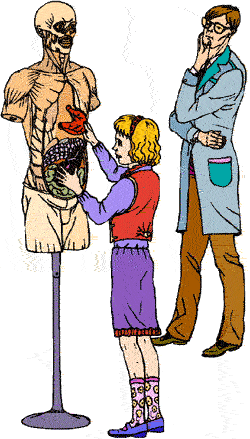 |
| The purpose of the respiratory system is ensure that an adequate level of oxygen is maintained in the blood stream and that the waste product 'carbon dioxide' is removed from the body. Think of the respiration system as a upside down tree. The further you go along the system the smaller the branches get. Look at the diagram below and you will see what I mean. |
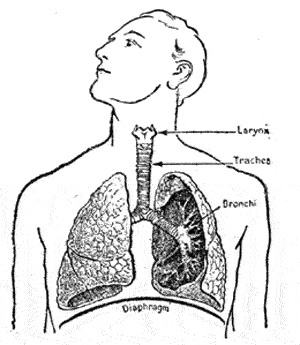 |
There are no muscles in the lungs, so what pumps the air in and out. First there are muscles between your ribs that contract and pull your chest up and out. Try it! Put your hand on your chest and take a deep breath in. What direction did your hand go?
Along with your rib muscles, there is a very large muscle below your ribs called the diaphragm muscle. As it contracts it pulls downward. The combination of these two muscle actions creates a vacuum in your lungs and air rushes in. When all these muscles relax the lung volume is reduced and air is forced out.
In the diagram below, we can clearly see the upside down tree design. When you breath in air rushes down the trachea (trake ea) and then divides into the left and right bronchi (the the plural word we use). From there the air is further divided into smaller and smaller bronchioles until it finally arrives at little sacs called alveoli .

Here in the alveola , the oxygen enters the blood stream while the excess carbon dioxide leaves the blood and is exhaled from the lungs. This process is called gas exchange .

|
© 2002 Alberta Online Consortium
|
2. The Circulatory System
Lesson 10
Science in Action 8
Pages 135-140
ScienceFocus 8
Pages 146-147
The circulation system's job is to transport materials around the body. It consists of the heart, arteries, veins, capillaries and blood. Each and every cell from the tip of your nose to the tip of your toes needs to be supplied with nutrients (food) and oxygen. These products allow your cells to carry on life processes called cellular respiration. During cellular respiration, waste products are created that could poison and kill the cells if they are not removed, so the blood collects these waste products and delivers them to the appropriate organ for removal from the body.
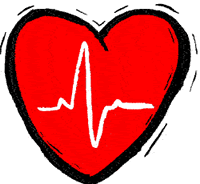
heart and circulation system
human circulation and blood
The Heart
| Every circulation system needs a pump to circulate materials around. Our heart is a four chambered pump. If you look at the diagram of the heart in your text you will find that part is red and the other part is blue. Do you know what that means? When blood carries fresh oxygen from the lungs it is quite a bright red so the diagrams show the oxygen rich blood flow in and away from the heart as bright red. This blood flows out to all the cells in your body. The blood arriving back at the heart that is low in oxygen is more purplish in colour and is indicated by the blue part of the diagram. |
Click on the above image to learn about your heart
|
Arteries, Veins and Capillaries
Blood is carried away from the heart by arteries and back to the heart in veins . But what happens in between the arteries and the veins? As the blood flows away from the heart the arteries get smaller and smaller until they are so small you can no longer see them with your eyes. Just like the branches of a tree, the further you go from the heart, the more the arteries branch and branch again until each and every cell is near a small artery Each very small artery is called an arteriole . Now the blood vessels change to capillaries. Capillaries are very thin walled blood vessels that allow the exchange of oxygen, carbon dioxide, nutrient and wastes between the blood and the body's cells. Both carbon dioxide and oxygen are carried by the red blood cells.
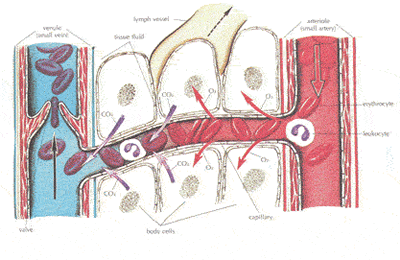
You can also see white blood cells in the diagram. They patrol your body looking for 'bad guys' like bacteria or viruses. They are part of your immune system that fights and kills anything that is 'not you'. The blood also carries particles called platelets . Platelets create patches to stop bleeding from cuts.
|
Immune System
At the website called cellsalive.com . watch the presentation called the anatomy of a splinter.
When you arrive at the site, click on cell gallery and then on ' anatomy of a splinter '. |
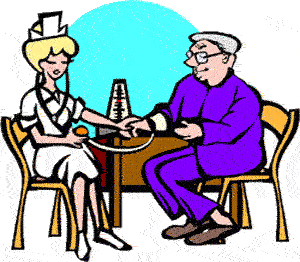 |
Blood Pressure Blood pressure can be defined as the measure of the pressure in the circulatory system. There are two pressure levels; the pressure in the system when your heart is beating - the systolic pressure, and the pressure when your heart is momentarily at rest - your diastolic pressure. |
| As we get older the pressure tend to climb higher. This can be dangerous as it can lead to heart disease and strokes. It is important to remain active, eat a balanced diet and try not to gain weight as we get older as these are the major variables that can affect blood pressure. The sphygmomanometer, otherwise know as a blood pressure cuff is displayed at the right. |
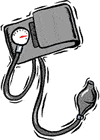 |
Password:brainpop .
|
© 2002 Alberta Online Consortium
|
3. The Digestive System
Lesson 11
Science in Action 8
Pages 126-130
ScienceFocus 8
Pages 149-150
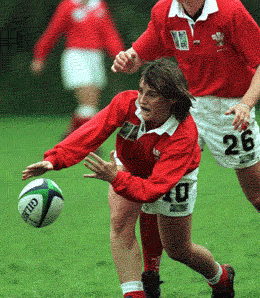 |
Like all living organisms we need energy to carry on our day to day activities. At peak times of activity, like these women playing rugby, large amounts of energy are needed by our cells over a short period of time. So it is important that we eat a well balanced diet that includes proteins, carbohydrates and lipids. But the food we eat is much too large to be useful to our cells. The purpose of the digestive system is to break down the food we eat into smaller pieces that can be carried by the circulation system and used by our cells. |
Background Information
There are two types of digestion; mechanical digestion and chemical digestion .
Mechanical digestion involves actions that physically break food apart. Activities such as chewing and the muscular movement of your stomach are considered to be forms of mechanical digestion. As food is torn apart into smaller pieces the surface area is increased. This allows digestive juices to work faster.
Chemical digestion involves the use of enzymes and acid to chemically break down large molecules into smaller ones. For example, chemical digestion starts in the mouth and as your saliva begins the breakdown of starch in to sugar.
Now its time to watch an animated video on digestion.
Password: brainpop
Then type in the word "digestion" and select proper video.
|
Try This!
Find a cracker and scrap off all the salt. If its an unsalted cracker all the better. Chew the cracker but do not swallow it. After one minute how does it taste?
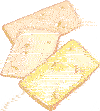 After five minutes how does it taste? What do you think happened to the cracker as you chewed it over the five-minute period? |
Examine the diagram below. By the end of this lesson you should be able to identify the major parts of the digestive system.
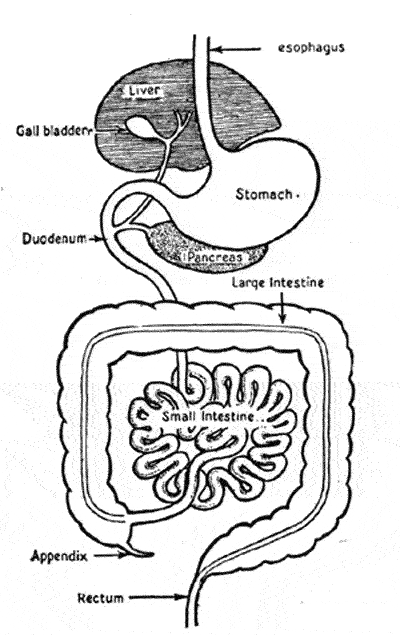 |
Both your trachea and your esophagus begin at the back of your throat. Swallowing food into your trachea would not be a good idea. Why? (Think back to the lesson on respiration.) There is a small flap of skin, called the epiglottis , which closes over the trachea as you swallow.
The food is then directed to the esophagus. What do you think causes the food to move down into the stomach? Perhaps its by the force of gravity. But astronauts live in the gravity free environment on the space shuttle and they can still eat, so it must be something else. Your digestive system uses the muscles along the digestive pathway to push the food along in waves. This pushing action is called peristalsis .
|
Both chemical and mechanical digestion occur in the stomach . While muscles squeeze and churn the food, enzymes and acid are added. This combination of actions causes the food to turn to the consistency of a milkshake. But if you have ever gotten sick to your stomach, you know that it neither looks nor tastes like a milkshake! The strong acid breaks down proteins like meats and milk products.
|
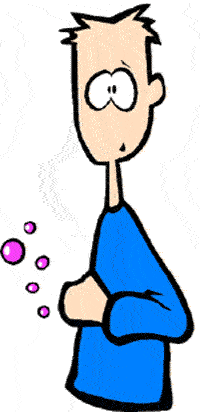 |
But the stomach is made of proteins! How does it keep from being eaten away? Hmmmm, what did you learn about the stomach in the movie that prevented this problem?
After 2 to 3 hours this ground-up food now enters the small intestine . Immediately, it is mixed with enzymes from the pancreas and gallbladder and any fats that you ate are further broken down.
The inside of the small intestine is covered with very small finger-like projections called villi . These villi increase the surface area for absorbing food. By the time the food particles reach the villi in the small intestine they are small enough to be able to be absorbed through the thin walls of the villi and into the blood stream. This process is called absorption should sound familiar, as it is very similar to gas exchange in the lungs.
Any food particles that aren't absorbed in the small intestine are passed along to the large intestine . Here, any remaining water, minerals and vitamins are absorbed and the remaining material compacted and stored in the rectum as feces until you go to the bathroom.
![]() Exercise 3.3: The Digestive System
Exercise 3.3: The Digestive System
|
4. The Excretory System
Lesson 12
Science in Action 8
Pages 135-140
ScienceFocus 8
Pages 146-147
Lesson 12: The Excretory System
| Waste products are created in all living organisms. They might come from cell metabolism or the removal of dead cell materials. In people, the blood stream picks up wastes from cells, but where does it go from there? In this lesson we will briefly examine how the body gets rid of waste products. |
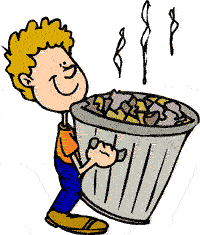 |
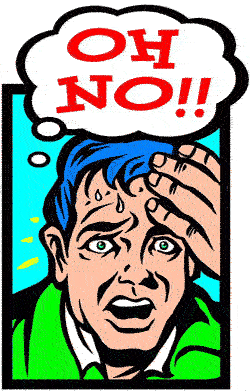 |
Your skin's main purpose is to protect your internal systems against invading organisms like bacteria and help regulate body temperature by sweating when you are too hot and shivering when you are too cold. But waste salts and heat are also removed from the body through the skin in the form of perspiration (sweat). |
Your bodys cells produce ammonia as a waste product which is released into your blood plasma (the liquid part of your blood). Your circulation system then carries the ammonia to the liver. The liver is considered to be part of the digestion system as it makes the bile that is used to break down fats. But it also converts ammonia, which is very poisonous, into the less poisonous chemical called urea . This urea continues its journey in the blood stream until it reaches the kidneys.
Your kidneys are the main organs of your excretory system. Through a complex process, they remove excess water, urea and salts to produce urine . The urine leaves the kidneys and flow down through two ureters into the bladder where it is stored until you go to the bathroom.
|
Examine the diagram on the right.
On your test you must be able to identify the all the major parts. |
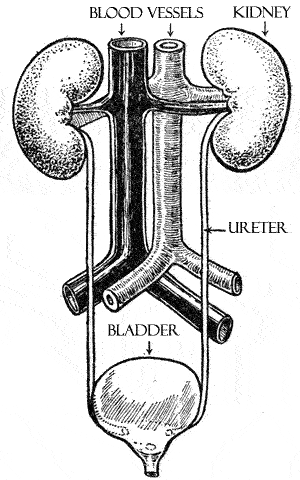 |
6. Unit 2 Section 3 Quiz
You will have two opportunities to write this section quiz. This quiz consists of 10 questions. Use the results from your 1st attempt to help you prepare for your second attempt. Your best score will be taken as your assessment mark. You have 15 minutes to complete this multiple choice quiz.



